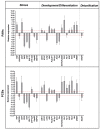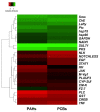PAHs and PCBs Affect Functionally Intercorrelated Genes in the Sea Urchin Paracentrotus lividus Embryos
- PMID: 34830379
- PMCID: PMC8619768
- DOI: 10.3390/ijms222212498
PAHs and PCBs Affect Functionally Intercorrelated Genes in the Sea Urchin Paracentrotus lividus Embryos
Abstract
Polycyclic aromatic hydrocarbons (PAHs) and polychlorinated biphenyls (PCBs) represent the most common pollutants in the marine sediments. Previous investigations demonstrated short-term sublethal effects of sediments polluted with both contaminants on the sea urchin Paracentrotus lividus after 2 months of exposure in mesocosms. In particular, morphological malformations observed in P. lividus embryos deriving from adults exposed to PAHs and PCBs were explained at molecular levels by de novo transcriptome assembly and real-time qPCR, leading to the identification of several differentially expressed genes involved in key physiological processes. Here, we extensively explored the genes involved in the response of the sea urchin P. lividus to PAHs and PCBs. Firstly, 25 new genes were identified and interactomic analysis revealed that they were functionally connected among them and to several genes previously defined as molecular targets of response to the two pollutants under analysis. The expression levels of these 25 genes were followed by Real Time qPCR, showing that almost all genes analyzed were affected by PAHs and PCBs. These findings represent an important further step in defining the impacts of slight concentrations of such contaminants on sea urchins and, more in general, on marine biota, increasing our knowledge of molecular targets involved in responses to environmental stressors.
Keywords: aromatic hydrocarbons; polychlorinated biphenyls; sea urchin.
Conflict of interest statement
The authors declare no conflict of interest.
Figures




Similar articles
-
Sub-Chronic Effects of Slight PAH- and PCB-Contaminated Mesocosms in Paracentrotus lividus Lmk: A Multi-Endpoint Approach and De Novo Transcriptomic.Int J Mol Sci. 2021 Jun 22;22(13):6674. doi: 10.3390/ijms22136674. Int J Mol Sci. 2021. PMID: 34206685 Free PMC article.
-
Morphological and molecular responses of the sea urchin Paracentrotus lividus to highly contaminated marine sediments: The case study of Bagnoli-Coroglio brownfield (Mediterranean Sea).Mar Environ Res. 2020 Feb;154:104865. doi: 10.1016/j.marenvres.2019.104865. Epub 2019 Dec 17. Mar Environ Res. 2020. PMID: 32056706
-
Assessment of sediment toxicity in the Lagoon of Venice (Italy) using a multi-species set of bioassays.Ecotoxicol Environ Saf. 2016 Jan;123:32-44. doi: 10.1016/j.ecoenv.2015.09.002. Epub 2015 Sep 26. Ecotoxicol Environ Saf. 2016. PMID: 26409652
-
Physical and chemical threats posed by micro(nano)plastic to sea urchins.Sci Total Environ. 2022 Feb 20;808:152105. doi: 10.1016/j.scitotenv.2021.152105. Epub 2021 Dec 2. Sci Total Environ. 2022. PMID: 34863733 Review.
-
Cadmium stress effects indicating marine pollution in different species of sea urchin employed as environmental bioindicators.Cell Stress Chaperones. 2019 Jul;24(4):675-687. doi: 10.1007/s12192-019-01010-1. Epub 2019 Jun 5. Cell Stress Chaperones. 2019. PMID: 31165437 Free PMC article. Review.
Cited by
-
Exposure to Toxicants Affects Everyone, Especially the Very Young.Int J Mol Sci. 2022 Jun 29;23(13):7232. doi: 10.3390/ijms23137232. Int J Mol Sci. 2022. PMID: 35806235 Free PMC article.
-
Transcriptomes reveal the involved genes in the sea urchin Mesocentrotus nudus exposed to high flow velocities.Sci Rep. 2022 Aug 5;12(1):13493. doi: 10.1038/s41598-022-17793-w. Sci Rep. 2022. PMID: 35931770 Free PMC article.
-
Gene Expression Detects the Factors Influencing the Reproductive Success and the Survival Rates of Paracentrotus lividus Offspring.Int J Mol Sci. 2022 Oct 24;23(21):12790. doi: 10.3390/ijms232112790. Int J Mol Sci. 2022. PMID: 36361581 Free PMC article.
References
-
- Gattuso J.P., Magnan A.K., Bopp L., Cheung W.W.L., Duarte C.M., Hinkel J., Mcleod E., Micheli F., Oschlies A., Williamson P., et al. Ocean solutions to address climate change and its effects on marine ecosystems. Front. Mar. Sci. 2018;5:337. doi: 10.3389/fmars.2018.00337. - DOI
-
- Kendall M.A., Burrows M.T., Southward A.J., Hawkins S.J. Predicting the effects of marine climate change on the invertebrate prey of the birds of rocky shores. Ibis. 2004;146:40–47. doi: 10.1111/j.1474-919X.2004.00326.x. - DOI
-
- Fangue N.A., O’Donnell M.J., Sewell M.A., Matson P.G., MacPherson A.C., Hofmann G.E. A laboratory-based, experimental system for the study of ocean acidification effects on marine invertebrate larvae. Limnol. Oceanogr. Methods. 2010;8:441–452. doi: 10.4319/lom.2010.8.441. - DOI
MeSH terms
Substances
LinkOut - more resources
Full Text Sources
Miscellaneous

